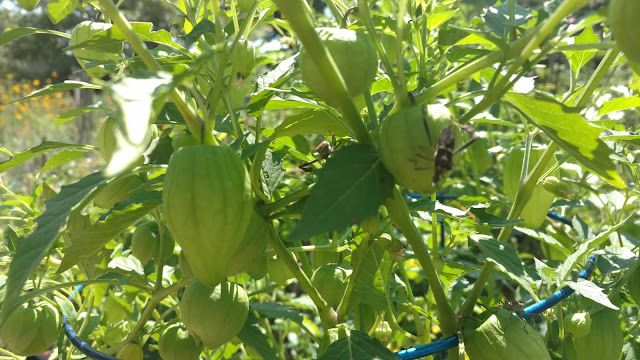
|
Can you see the leaf-footed bugs? They tend to stay together. (Photo: Debbie Arrington)
|
Leaf-footed bugs appear late this summer in Sacramento
Alien pests were attacking my tomatillos!
That was my immediate reaction when I saw these weird critters perched on a bush in my community garden. While I screamed an appropriate expletive, they were unafraid of my approach. The group of four ignored me, intent on sucking the juice out of the ripening tomatillos while eying the red beefsteaks nearby.
Their food focus made it much easier for me to grab them in a tissue and squish them. (It was the next best alternative to drowning them in soapy water.) I had to act fast and I hadn't brought a bucket (or soap).
This was my first sighting of the leaf-footed bugs (Leptoglossus zonatus) in Sacramento this year. In recent summers, these stinkbug cousins seemed to be all over the Valley by June. When you see them, you remember them. Their angular bodies are about an inch long with strange legs; leaflike "thighs" give them their name. They are a true bug and attack many different types of plants, according to the UC Cooperative Extension Master Gardeners.
In home gardens, they primarily attack tomatoes, pomegranates and roses. They also have a huge appetite for almonds, pistachios, citrus and watermelon. But L. zonatus is opportunistic; it eats lots of different fruits, vegetables, nuts and flowers.
Those same traits in other pests, such as the brown marmorated stink bug, can be devastating. But leaf-footed bugs are easier to control. They're slow, stupid and stick together.
I've been acquainted with these stinkers for awhile.
“The females generally lay groups of shiny golden eggs on leaves of host trees,” Sacramento's Bug Man, retired state entomologist Baldo Villegas, told me last year for a Garden Detective column in The Sacramento Bee. “The eggs hatch usually about the same time, and they generally feed in groups as there is usually a pheromone that keeps the group together. This is also a clue to how to control them.”
What does Baldo do when he sees these bugs? Shake them off the bush.
“I consider these bugs a nuisance pest rather than a garden pest as one can easily control them by just shaking them into a bucket containing soapy water,” he said. “Once the bugs hit the soapy water, they usually drown.”
Because it's already mid-August, I figured these examples were likely second generation 2018 leaf-footed bugs. I just hadn't met their parents. They were nymphs, not yet strong fliers (although one did try to zip away). That also made them easier to catch and eliminate. Fully mature adults can escape by air; the nymphs cannot.
According to UC research, populations of leaf-footed bugs can vary quite a bit year to year due to weather and other factors. I've been on the look out for this pest's distinctive eggs. They look like itty-bitty amber bracelets; tiny golden eggs in a single-file line. The eggs can hatch in a week, but then the flightless nymphs take six to eight weeks before they can become airborne.
That's another key to control: Get them while they're young.
Next time I visit my garden, I'm bringing the bucket.

